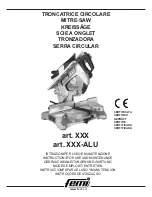
OPERATION
Cutting operation
CAUTION:
• Always hold the tool with the base flush with the
workpiece. Failure to do so may cause a slanted
cutting surface and blade breakage.
• Advance the tool very slowly when cutting curves or
scrolling. Forcing the tool may cause a slanted
cutting surface and blade breakage.
Turn the tool on without the blade making any contact.
Rest the base flat on the workpiece and gently move
the tool forward along the previously marked cutting
line. (Fig. 21)
Bevel cutting (Fig. 22 & 23)
CAUTION:
Always remove the battery from the tool before mak-
ing any adjustments.
With the base tilted, you can make bevel cuts at any
angle between 0° and 45° (left or right). Loosen the
base securing lever and move the base so that the
dent mark in the motor housing is aligned with the slot
in the base. Tilt the base until the desired bevel angle
is obtained. The edge of the motor housing indicates
the bevel angle by graduations. The tighten the base
securing lever to secure the base.
NOTE:
Always remove the plastic cover (chip shield) from the
tool when you make bevel cuts using an optional
guide rule (rip fence) or circular guide.
Flush cutting (Fig. 24)
Loosen th base securing lever and slide the base all
the way back. Then tighten the base securing lever to
secure the base.
Cutouts (Fig. 25 & 26)
Cutouts can be made with either of two methods A or
B.
A) Boring a starting hole:
For internal cutouts without a lead-in cut from an
edge, pre-drill a starting hole more than 12 mm in
diameter. Insert the blade into this hole and hold
the tool firmly against the workpiece to start your
cut.
B) Plunge cutting:
You need not bore a starting hole or make a
lead-in cut if you carefully do as follows.
1. Tilt the tool up on the front edge of the base,
with the blade point positioned just above the
workpiece surface.
2. Apply pressure to the tool so that the front
edge of the base will not move when you
switch on the tool and gently lower the back
end of the tool slowly.
3. As the blade slices into the workpiece, slowly
lower the base of the tool down onto the
workpiece surface.
4. Complete the cut in the normal manner.
Finishing edges (Fig. 27)
To trim edges or make slight dimensional adjust-
ments, run the blade lightly along the cut edges.
Metal cutting
Always use a suitable coolant (cutting oil) when
cutting metal. Failure to do so will cause significant
blade wear. The underside of the workpiece can be
greased instead of using a coolant.
MAINTENANCE
CAUTION:
Always be sure that the tool is switched off and the
battery cartridge is removed before carrying out any
work on the tool.
Cleaning clamp on blade holder
If chips or foreign matter get into the clamp on the
blade holder, clean out the clamp after removing it
from the blade holder.
Removing clamp
1. Push the blade installing lever in the (1) direction
to release it. (Fig. 28)
2. Pull the blade installing lever in the (2) direction
until it stops with a little click. If you have difficulty
pulling it out, try to do so while moving it back and
forth in the (3) direction.
3. Rotate the blade installing lever in the (4) direction
until it stops. The clamp will protrude from the
blade holder. (Fig. 29 & 30)
4. Remove the clamp from the blade holder while
rotating the clamp in the (5) direction. (Fig. 31)
Installing clamp
1. Make sure that the blade installing lever has been
rotated in the (4) direction until it stops. (Fig. 32)
2. Insert the clamp into the blade holder while rotat-
ing it in the (6) direction one quarter to one full turn
so that its slot will face forward. (Fig. 33)
CAUTION:
Do not rotate the clamp more than one full turn
when inserting in into the blade holder. If you do
so, the blade may not be tightened firmly.
3. Grasp the clamp with your fingers so that it will not
turn, then rotate the blade installing lever in the (7)
direction until it stops. The clamp will go in the
blade holder. (Fig. 34)
Replacing carbon brushes (Fig. 35 & 36)
Remove and check the carbon brushes regularly.
Replace when they wear down to the limit mark. Keep
the carbon brushes clean and free to slip in the
holders. Both carbon brushes should be replaced at
the same time. Use only identical carbon brushes.
Use a screwdriver to remove the brush holder caps.
Take out the worn carbon brushes, insert the new
ones and secure the brush holder caps.
To maintain product safety and reliability, repairs,
maintenance or adjustment should be carried out by a
Makita Authorized Service Center.
4334D (E) (’100. 8. 7)
11
Содержание 4334D
Страница 2: ...1 2 3 4 5 6 2 1 7 9 8 7 8 10 11 14 13 12 2 3 4 6 5 2 ...
Страница 3: ...9 10 11 12 13 14 15 16 17 19 1 4 2 3 21 22 23 20 24 15 16 5 19 24 25 19 6 8 18 3 ...
Страница 4: ...17 18 19 20 21 22 5 19 19 6 26 8 27 23 29 28 30 24 19 1 4 2 3 4 ...
Страница 5: ...25 26 27 28 29 30 19 1 4 2 3 21 22 23 20 31 5 21 20 32 4 5 ...
Страница 6: ...33 34 35 36 31 32 33 6 21 20 7 19 6 ...
Страница 86: ...86 ...
Страница 87: ...87 ...
Страница 88: ...PRINTED IN USA ...












































